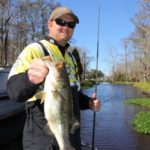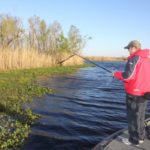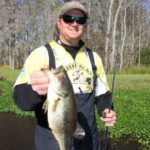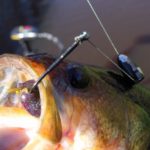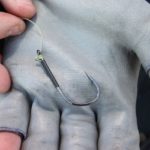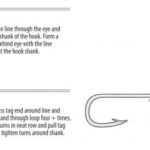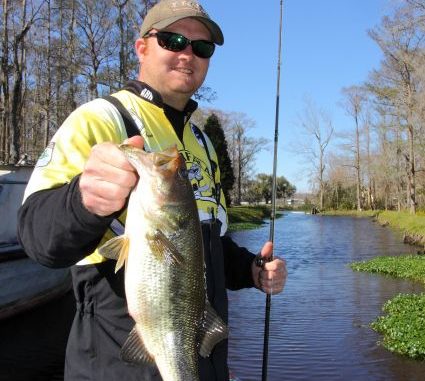
Grass mats might drive some anglers crazy, but anglers in the know understand that big bass hide in that vegetation. Here’s how to drag them to the boat.
Back in 2009 during the Bassmaster Central Open held in the Atchafalaya Basin, Elite Series angler and local favorite Cliff Crochet punched grass mats to earn his first trip to the Classic.
The Pierre Part pro proved the technique, when employed correctly and used under the right conditions, can be a deadly tactic for putting weight on the scale.
Basically fishing in his own backyard, Crochet employed the tactic with precision in the waters he grew up on. He used a heavy tungsten weight, a flipping hook and braided line — all basic elements required to punch grass for lunker bass.
But it’s not just a pro tactic; many of the unsung heroes of the bayous who fish blue-collar club tournaments also know just how effective punching grass can be.
One of those club anglers is 28-year-old Luke Fears, who is a member of the Atchafalaya River Rats Bass Club.
“I like throwing baits into grass, because you often get a better quality fish,” Fears said. “Throughout the year I find that I normally catch the bigger fish when I’m punching grass, whether it’s duckweed, hydrilla or lilies.
“It’s just where the bigger fish are. The better fish are going to be under grass somewhere.”
The Bayou Vista resident and I fished together east of Bayou Black Marina, south of the Intracoastal Waterway in an area locals call 70-mile Canal last March looking for likely mats of grass and shallow locations consisting of cattails and roseau cane.
Fears’ rig for punching grass was similar to Crochet’s in concept, with a few things the angler has learned on his own to make it more effective.
“I’ll rig up with a 1 1/2-ounce tungsten weight and I’ll use a bobber stopper, using it as a peg for my weight,” Fears said. “With that I’ll use a 3/0 straight-shank hook and tie it onto my line using a snell knot. It’s like a fish snare; you run your line through the front side of the hook and, once it’s cinched down, what it does basically is roll the hook forward.
“Most of the time it catches the bass right in the hard part of the mouth, where they usually don’t come off. It keeps them hooked well.”
It’s one thing to keep a bass hooked and another getting it through the thick grass mats you’ve punched through. I have to admit, I didn’t do so well. After mastering the punch-through step and enticing a bass to bite, in the excitement of the catch I lost it.
I could feel the weight of the fish. I could feel its power vibrating through my rod down to my hands. And in the melee I thought how this was going to be my personal best largemouth.
Fears said he matches the technique and thick cover with equipment that helps alleviate the issue I was fighting.
“I’ll use an extra-heavy-power rod, because it really helps pull them out of there,” he said. “I’ll also use 50- or 60-pound-test braided line. The heavier line really helps, too.
Besides grass mats, Fears likes to punch patches of thick flag grass in shallow areas of the marsh, where the root systems of these plants tighten the bottom, making it hard.
Fears went on to say that during late February and March bass make spawning beds in these harder bottom areas. Therefore, patches of flag grass should be primary targets for bass fishermen.
Of course, once you get the flip-and-punch-through part down and you’re through the mat, you still have to entice a bass to bite.
“I basically get the bait down under the grass and yo-yo it,” Fears said. “And, depending on the time of year, I adjust the number of times I yo-yo. When it’s cold and there is high pressure in late February and March I’ll yo-yo it five to 10 times to give fish a better look at the bait. Under normal conditions, with better weather, I’ll usually yo-yo it two or three times.
“I’ll also let it sit on the bottom a little longer — maybe a couple seconds each time.”
He said it’s imperative to pay close attention.
“Under tough conditions they don’t always hit on the initial fall,” Fears said. “But it seems just when you’re ready to pull it out of the grass, they take it.”
There are numerous jigs ready and available for punching grass, including Strikezone Lures Grassbuster jigs available in 3/8- to 1½-ounce weights.
Stanley has two options for grass-punchers: the Stanley punching jig in ¾- to 1 ¼-ounce weights and the Flip-Max jig in 3/8- to 1-ounce weights.
Many anglers prefer to fashion their own punching rigs, however. And most who do will typically rig it Texas style. The setup often dictates the type of weight grass-punchers prefer.
“The tungsten weight is so much smaller than the same weight lead weight,” Fears said. “For instance, a 1 ½-ounce tungsten might be three-quarters of an inch long, where 1 ½-ounce lead weights are longer and wider in diameter.”
The slimmer design of the tungsten can be important.
“What happens is fish grab the bait under the mat and, whether your fishing it Texas style or anything else with a weight on it, it has to pass through their mouth first before the hook goes into their lip,” Fears said. “Tungsten being smaller is ideal under mats because it doesn’t create separation in their mouth and allows more hook to hit their mouth instead of a big lead weight that opens (the fish’s) wider.”
Fears powered our first bass of the day through a likely mat he decided to check out — something he is particularly good at finding.
“I’ll scout areas where there are lots of mats to punch or even duck weed,” Fears said. “A lot of bass anglers will avoid (grass mats) because it’s tough to navigate or they prefer throwing spinnerbaits or maybe a worm or something. It’s better for me.
“The more mats the better. They’ll avoid it, and I’ll catch fish that get overlooked.”
The technique does takes patience, which a lot of bass anglers don’t have. Most bass anglers crank the trolling motor up on full speed and cast spinnerbaits and crankbaits faster than you can blink an eye.
But grass punchers don’t have that luxury.
When other bass anglers are covering ground in likely territory trying to develop some sort of consistent pattern on wood and structure, the grass puncher has to find a likely mat and stop. Only after the angler is convinced there are no bass lurking below the mat will he move on after several minutes.
The unique thing about punching grass mats is that it’s not limited to a particular time of year. During the winter and early spring, when north winds have the water pushed out of the marshes, mats absorb heat from the sun and providing bass with some comfort. The same is true during the summer.
When summer temperatures heat the water so much that bass become lethargic except during the early and latter parts of the day, they will get underneath mats of grass where it’s cooler.
Fears and the other blue-collar anglers of the bayou might never punch their way to the Bassmaster Classic like Crochet did back in ’09. But, it doesn’t mean the technique won’t prevent them from feeling like they had — when the scales tip in their favor.
